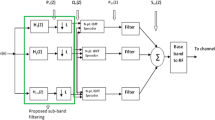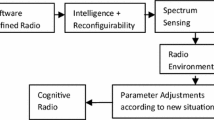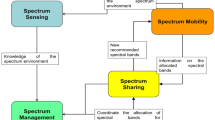Abstract
This paper provides the detailed simulation analysis of Filter Bank Multicarrier Cognitive Radio for doing tradeoff between the parameters of cognitive radio for achieving optimum performance. An attempt for tradeoff between different transmission-radio environment parameters has been done as this leads to an increase in spectrum efficiency by decreasing the spectral leakage which provides optimal performance. The optimization-tradeoff between different radio environment parameters is necessary for prediction and planning of future wireless communication systems. Transmission, reception and radio environment parameters play a key role in the performance enhancement of FBMC cognitive radio.
Similar content being viewed by others
Explore related subjects
Discover the latest articles, news and stories from top researchers in related subjects.Avoid common mistakes on your manuscript.
1 Introduction: role of cognitive radio in next generation wireless communication
A cognitive radio is essentially a software defined radio running under the control of an intelligent software package called a “cognitive engine”. The term cognitive radio (CR) was first defined by Joseph Mitola III [1,2,3]. According to Mitola, CR technology is the “intersection of personal wireless technology and computational intelligence, “where CR is defined as a smart radio that would be self-aware, RF-aware, user-aware, with a lot of high-fidelity knowledge of the radio environment”. Cognitive radios are aware of their surrounding environment and bandwidth availability, and are able to dynamically tune the spectrum usage on the basis of location, nearby radios, time of day and other factors. This provides for better use of the spectrum as well as reduced power consumption. Various devices will be able to detect other radios around them and work together to optimize the use of spectrum, allocate resources, and ultimately communicate with their peers [4]. Cognitive radio offers new opportunities for the wireless industry and consumers to cope with the ever increasing mobile data traffic. Cognitive technologies can significantly enhance the overall utilization of spectrum, by allowing sharing in bands where it was earlier not possible [5].
2 Drivers of the present problem
A fundamental problem facing the future wireless communication systems is where to find the suitable spectrum bands to meet the demand of future services [6]. In order to overcome this problem and improve spectrum utilization, cognitive radio concept has evolved. To build a highly adaptive radio technology that learns from the environment to best serve its user, multi rate signal processing techniques need to be developed for different functionalities of cognitive radio [7, 8].
2.1 Role of FBMC over OFDM in cognitive radio physical layer
Multi rate systems and filter banks have played an important role in source coding and compression for contemporary communication applications [9, 10]. Multi rate DSP is applied in digital systems where more than single sampling rate is the requirement [11]. Filter Bank Multicarrier (FBMC) has advantages over OFDM such as reduced guard bands between users and improved spectral efficiency due to lack of Cyclic Prefix and reduced synchronization requirements due to very good spectral containment. Hence, this Filter Bank Multicarrier Technique is used in spectrum sensing in cognitive radio. Various applications of multi rate signal processing are in the field of Communication Systems, Speech & Audio Processing Systems, Antenna & Radar Systems. Advanced techniques on multi rate signal processing can be applied for digital information processing due to the advantages like lesser computational requirements, less storage for filter coefficients, less finite arithmetic effects, low requirement of filter order in multi rate application, less sensitivity to filter coefficient length [12]. Filter Bank Multicarrier System (FBMC) with offset quadrature amplitude modulation (OQAM) can achieve smaller inter symbol interference (ISI) and Inter Carrier Interference (ICI) without using the CP by utilizing well designed pulse shapes that satisfy the perfect reconstruction conditions [13, 14]. Moreover, the problem of the spectral leakage can be solved by minimizing the side lobes of each sub carriers which leads to high efficiency (in terms of spectrum and interference). Filter Bank Multicarrier (evolving OFDM-OQAM) techniques have been recommended to replace conventional OFDM multicarrier technique for CR transmission [15] (Fig. 1).
3 Flowchart for present study: \(\text {Lp}=\text {KM}+1\) (performance analysis of modified FBMC)
A Flowchart has been prepared for study of effect of sub channels M on prototype filter length Lp for FBMC cognitive radio has been discussed. The distinctive feature of the FBMC design technique has ability to provide improved frequency selectivity through the use of longer and spectrally well shaped prototype filters. In the present case, more emphasis has been laid on the \(\text {Lp}=\text {KM},\text {KM}-1-\text {D}, \text {KM}+1 - \text {D}\) as a specific prototype filter length, under the assumption of Group Delay D of filter as zero in all the cases (Fig. 2).
3.1 Results and discussion
Different graphic plots have been obtained between the various parameters namely number of sub channels M, bit error rate (BER), signal to noise ratio (SNR), prototype filter length \(\text {Lp} = \text {K}\times \text {M}+1\) at a fix value of Overlapping factor \(\text {K}=4\). The spectrum sensing is performed by measuring the signal strength at the outputs of the subcarrier channels at the receiver. The cognitive radio system is able to transmit over the direct link more than that when the direct link is blocked for all subcarriers in the source side. The impact of the present study of FBMC CR is highlighted through the role of number of sub channels. Readjustment of various parameter levels leads to optimization between different radio environment parameters under varying strategic conditions. The computational complexity of the FBMC cognitive radio is studied under the effect of K, M and Lp. For FBMC system, the prototype filter coefficients are assumed to be matching the Physical Layer for Dynamic Spectrum Access (PHYDAS) coefficients with overlapping factor \(\text {K} = 4\) (optimum). Actually, the entire process here involves the three steps. fixing the subcarriers, matching the subcarriers and re-adjusting the assigned subcarriers as per the system requirement on an average basis. For optimization and tradeoff sake, the number of subcarriers is taken to be greater than 64. The literature survey on FBMC shows that the different subcarriers are adjusted in such a way that the interference to the primary user by secondary users is kept to a minimum. Moreover, the impact of different constraint values on the system performance is investigated. This section formulates a problem to select and match some subcarriers for transmission and use the rest only for direct transmission. The FBMC CR in physical layer is a potential candidate for future wireless communication system. A Bandwidth of 10 MHz (within a useful BW range of 6–10 MHz) with \(\text {M}=64,128,256,512\) subcarriers has been taken into consideration in the present scenario. The subcarriers are allocated sequentially to the users with optimum results. In Fig. 3 BER is found to be decreasing with increasing values of SNR. A staircase plot between Lp and BER has been shown in Fig. 4. Plots between various performance parameters have been depicted in Figs. 5, 6, 7, 8 and 9.
3.2 Results and discussion: \(\text {Lp}=\text {KM}\)
Figure 10 shows BER versus SNR plot at different values of M. The trend for M values has been clearly shown here. At \(\text {M}=64, \text {BER}=1.45\) at \(\text {SNR}=0\) dB, \(\text {BER}=1.1\) at \(\text {SNR}=1\) dB, \(\text {BER}=0.75\) at \(\text {SNR}=2\) dB, \(\text {BER}=0.45\) at \(\text {SNR}=3\) dB, \(\text {BER}=0.3\) at \(\text {SNR} = 4\) dB, \(\text {BER}=0.1\) at \(\text {SNR}=5\) dB. It is very clear that at higher values of M initial values of BER are found to be higher than 1.45 at \(\text {SNR}=0\) dB. The values of SNR chosen are well within the range (−5 to \(+30\) dB) as per specifications of IEEE 802.22 Standard for FBMC cognitive radio. Figure 11 shows the plot between Lp and BER which shows that beyond \(\text {Lp}=500\), BER is found to rise to a value \(10^{-0.2}\) till \(\text {Lp}=2000\). Figure 12 shows plot between Lp and SNR which clearly shows SNR decrease beyond \(\hbox {Lp}=10^{3}\). Figure 13 shows the plot between M and BER which indicates that beyond \(\hbox {M}=10^{2}\), BER increases to \(10^{-0.2}\). Figure 14 shows with M more than \(10^{2}\), Lp becomes more than \(10^{3}\). In Fig. 15, SNR decreases to 2 dB beyond \(\hbox {M}=10^{2}\). Various performance parameters have shown that with increasing BER, SNR is found to decrease and vice versa.
3.3 \(\text {Lp}=\text {KM}-1\)
The plots obtained between various parameters, number of sub channels M, BER, SNR, prototype filter length \(\text {Lp}=\text {K}\times \text {M}+1\) at a fix value of overlapping factor \(\text {K}=4\) here (Figs. 16, 17, 18, 19, 20, 21, 22).
Below are the Matlab graphs obtained between various performance parameters namely, channel capacity, spectral efficiency, BER, Eb/No, interference, power, bandwidth for performance analysis of FBMC cognitive radio (Figs. 23, 24, 25, 26, 27, 28, 29, 30, 31).
where P is the peak data rate taken as \(15.36 \times 10^{6}\) and \(\hbox {R}_{\mathrm{{average}}}\) is the modulating and coding scheme average factor while B represents the Channel Bandwidth \(=\) 6, 7, 8, 9, 10 MHz in the useful range as per the PHYDAS (Physical Layer for Dynamic Spectrum Access) Specifications D5.1 [14]. The well known formula for calculating Channel Capacity C, as per Shanon Hartley Theorem, is stated as
Table 1 shows the BER values computed in FBMC CR Simulink model using AWGN channel at different values of Eb/No. At a decimation factor 1/3 in FIR decimation filter and interpolation factor of 3 in FIR interpolation filter, it has been found that BER comes out to be 0.1223 approximately. While for the same model at a decimation factor 1/2 and interpolation factor of 2, the BER comes out to be around 0.01235. At a decimation factor of 1/8 and interpolation factor of 8, BER calculated through Simulink model is approx 0.01224.
Table 2 shows the calculated values of AWGN channel capacity for FBMC-CR system under the effect of varying Eb/No (dB) as 12, 13, 14, 15, 16 for different values of \(\text {BW}=6,7,8,9,10\) MHz when sample time \(\text {Ts}=1/4000\) (Figs. 32, 33, 34, 35, 36, 37, 38, 39, 40; Tables 3, 4, 5, 6, 7, 8).
3.4 OFDM: BER-SNR performance analysis
4 Evaluation of experimental environment and future scope of work
The comparative BER performance analysis of FBMC CR based Simulink model under binary symmetric channel (BSC) with different error probabilities and under the effect of band filter and Two Channel Synthesis Sub band filter with AWGN channel in between has been shown in Table 9.
The study is useful to improve the performance of CR system under different signal impairments, channel modulation techniques for Physical layer CR. The computer modeling and simulation of interference analysis by using different techniques in Physical layer CR wireless environment has led to the improvement in terms of gain for channel capacity and spectral efficiency with minimum BER and least power requirements. Better utilization of available spectrum rf bandwidth is possible by reduction of multiple access interference, a major factor in system capacity and quality of communication at a minimum power level. The proposed CR simulators can be used for capacity, coverage and quality analysis. It works on a trade-off algorithm of channel capacity, spectral efficiency, BER, power, interference, bandwidth, SNR (Eb/No), overlapping-factor/prototype filter length, number of sub channels used, power spectral density, interpolation, decimation, single channel/multi channel sub band processing through multirate filter banks in a TMUX configuration. So, this study is useful for CR wireless network planning, optimization with various mobile services. Rayleigh, Rician, Nakagami, Weibull fading channels are available to replace AWGN and binary symmetric channel models to simulate the system under mobility radio channel. The performance higher than optimal can be achieved by incorporating more influential parameters of interest in system level simulation models using adaptive signal processing approach. Attempts should be made to develop newer models of CR on lab view, system view within SNR range for cognitive radio operation \(-5\) to \(+40\) dB. Radio Spectrum Management at Physical Layer CR still may not provide sufficient Bandwidth. Spectrum sensing in cognitive radio under media access control layer of OSI Model can be done as spectrum sensing cognitive radio enhancement to ProToMAC (Proactive Transmit Opportunity Detection at MAC Layer). The work can be extended to develop algorithms which further enhance the network coverage and higher interference suppression in a cognitive radio network.
5 Conclusion
This BER versus SNR plot clearly depicts that in Filter Bank Multicarrier approach, followed for AWGN Channel State Estimation purpose shows that at \(\text {SNR}=0\) dB, BER is at peak while with increase in SNR beyond 0 dB, BER consistently remains minimal i.e. approximately zero which is good trend from efficient communication signal processing and Nyquist pulse shaping point of view. In this section, the problem of capacity maximization and Spectral Efficiency Enhancement for FBMC-CR multi-user resource allocation based on channel type is considered. Maximization of system capacity, based on available error-free instantaneous estimated channel state information at the transmitter, is the goal. Moreover, it is shown, through Monte Carlo simulations, that numerical results absolutely coincides the analytical computations.
References
Schaich, F. (2010). Filterbank based multi carrier transmission (FBMC) evolving OFDM: FBMC in the context of WiMAX. In Proceedings of European wireless conference (EW) (pp. 1051–1058), Lucca, Italy.
Lélé, C., Javaudin, J., Legouable, R., Skrzypczak, A., & Siohan, P. (2008). Channel estimation methods for preamble-based OFDM/OQAM modulations. European Transactions on Telecommunications, 19(7), 741–750.
Du, J., & Signell, S. (2008). Pulse shape adaptivity in OFDM/OQAM systems. In Proceedings of international conference on advanced Infocomm Technology, China.
Kozek, W., & Molisch, A. (1998). Nonorthogonal pulseshapes for multicarrier communications in doubly dispersive channels. IEEE Journal on Selected Areas in Communications, 16(8), 1579–1589.
Trigui, I., Siala, M., Affes, S., Stephenne, A., & Boujemâa, H. (2007). Optimum pulse shaping for OFDM/BFDM systems operating in time varying multi-path channels. In Proceedings of IEEE global telecommunications conference (pp. 3817–3821), USA.
Du, J., & Signell, S. (2007). Classic OFDM systems and pulse-shaping OFDM/OQAM systems. Technical Report. KTH—Royal Institute of Technology, pp. 1–32.
Bolcskei, H., Duhamel, P., & Hleiss, R. (1999). Design of pulse shaping OFDM/OQAM systems for high data-rate transmission over wireless channels. In Proceedings of IEEE international conference on communication (ICC) (Vol. 1, pp. 559–564), Canada.
Haas, R., & Belfiore, J. (1997). A time-frequency well-localized pulse for multiple carrier transmission. Wireless Personal Communications, 5(1), 1–18.
Strohmer, T., & Beaver, S. (2003). Optimal OFDM design for time-frequency dispersive channels. IEEE Transactions on Communications, 51(7), 1111–1122.
Martin, K. W. (1998). Small side-lobe filter design for multi tone data communication applications. IEEE Transactions on Circuits and Systems II: Analog and Digital Signal Processing, 45(8), 1155–1161.
Amini, P., Kempter, R., Chen, R. R., Lin, L., & Farhang-Boroujeny, B. (2005). Filter bank multitone: A physical layer candidate for cognitive radios. Software defined radio technical conference (SDR 2005), California, 14–18 November 2005.
Amini, P., Azarnasab, E., Akoum, S., Mao, X., Rao, H., & Farhang-Bouroujeny, B. (2007). Implementation of a cognitive radio modem. In Software defined radio technical conference, Denver, CO, 5–9 November 2007.
Renfors, M. PHYDYAS:D5.1 Report. Tampere University of Technology, Finland.
Phydas Report. (2009). Prototype filter and filter bank structure optimization (pp. 1–102).
Zhao, O., & Sadler, B. M. (2007). A survey of dynamic spectrum access. IEEE Signal Processing Magazine, 24(3), 79–89.
Kang, A. S., & Vig, R. (2014). Comparative performance analysis of modified FBMC prototype filter under strategic conditions. European Journal of Scientific Research, 125(3), 362–369.
Kang, A. S., & Vig, R. (2015). Computer aided BER performance analysis of Filter Bank Multicarrier based cognitive radio under binary symmetric radio fading channel. Springer Journal of Wireless Personal Communication, 81(2), 15.
Kang, A. S., & Vig, R. (2016). Comparatative performance evaluation of modified prototype Filter Bank Multi Carrier cognitive radio under constraints of Lp, K, N and D. The Computer Journal, 59(3), 1–13.
Kang, A. S., Vig, R., et al. (2016). Comparative analysis of Energy Detection spectrum sensing of cognitive radio under Wireless Environment using SEAMCAT. International Journal of Advanced Computer Science and Applications, 7(1), 493–498.
Kang, A. S., & Sharma, V. (2016). Effect of prototype filter length on PAPR reduction and side lobe tail attenuation on autocorrelation in FBMC cognitive radio. International Journal of Advanced Information Systems & Technology, 51, 38–48.
Acknowledgements
The first author is thankful to Prof. Dr. Jasvir Singh, Department of Electronics Technology, GNDU, Amritsar for valuable discussion on the present topic. The help rendered by Prof. B. P. Patil, Army Institute of Technology, Pune is also acknowledged.
Author information
Authors and Affiliations
Corresponding author
Rights and permissions
About this article
Cite this article
Kang, A.S., Vig, R. Performance analysis of FBMC-CR through optimization: tradeoff between various performance parameters in the cognitive radio environment. Telecommun Syst 65, 567–589 (2017). https://doi.org/10.1007/s11235-016-0252-5
Published:
Issue Date:
DOI: https://doi.org/10.1007/s11235-016-0252-5












































